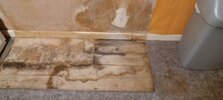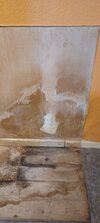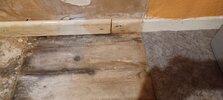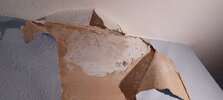Helping my Neighbour replace his kitchen.
Removed some units yesterday and found some damp on the wall and floor.
1930s semi
Internal wall that backs onto the chimney breast.
There is damp in the chimney. Salts and paper peeling upstairs on the front of the breast. Some bubbling near the ceiling in the bedroom above the kitchen.
Remove the damaged plaster back to brick but then what? I can plaster well enough for a finish that will be behind units.
Worth using any damp treatment like dry rods? Or pointless given the chimney is leaking? I am guessing that this is the cause of the damp in the kitchen.
Floor looks a lot better today than it did yesterday. Felt wet to the touch yesterday.
Worth lifting the floor boards to check under them? Do the boards need replacing?
I presume the 'concrete' part of the floor in an old hearth.
VERY tight budget.
I will be DIYing what I can for him.
Pics of kitchen wall/floor and upstairs breast.
Thanks
Removed some units yesterday and found some damp on the wall and floor.
1930s semi
Internal wall that backs onto the chimney breast.
There is damp in the chimney. Salts and paper peeling upstairs on the front of the breast. Some bubbling near the ceiling in the bedroom above the kitchen.
Remove the damaged plaster back to brick but then what? I can plaster well enough for a finish that will be behind units.
Worth using any damp treatment like dry rods? Or pointless given the chimney is leaking? I am guessing that this is the cause of the damp in the kitchen.
Floor looks a lot better today than it did yesterday. Felt wet to the touch yesterday.
Worth lifting the floor boards to check under them? Do the boards need replacing?
I presume the 'concrete' part of the floor in an old hearth.
VERY tight budget.
I will be DIYing what I can for him.
Pics of kitchen wall/floor and upstairs breast.
Thanks







